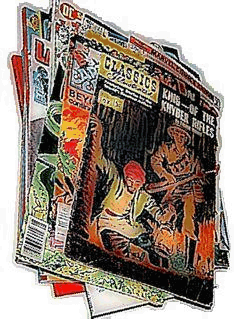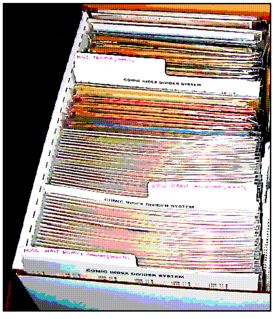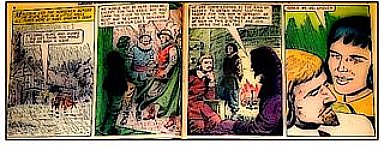Comic Book Content Literacies
To Explore With Your Students!
Emboldened with my first Real World content successes, I introduced comic book content next! I took a stack of comic books into my classroom. Four dozen were enough for my 44 students and me.

My father and uncle introduced me to the delights of comic books from my earliest years. I was well practiced in this content literacy and respected its graphic storytelling power, the call of its adventure, and the surprise in its unexpected word play.
I watched what each student chose. Most talked aloud to their friends about personal comic book choices. Others found quiet places to read.
As with other adventures in Real World content materials, the comic books absorbed their attention. They wanted to read as many comics as they could put their hands on.
I planned to segue into cross-curricular reading and writing activities from these comics.
My kids would find much, much more for me to include, to explain, to link, to investigate. I might know where we’d end up on the course of study but they would show me what paths to take. And when to proceed.

Not long into this activity, they chose to sort… the imposed-order-onto-chaos step of active learners. Should they group by comic book genre – all westerns together – all Duck family adventures – all superheros? Should they build sets to include a sample of each genre? Should they have thicker comics with thinner ones? Should each size be included with each set?
We spent the first morning familiarizing ourselves with genre – they loved this new word and preferred its use to the less specific words “kind” and “type”. The preference of this new term elevated their attention to debating genre characteristics and grouping by these. During these debates, students also provided commentary on what comic book content they liked best, their favorite characters, and stories.
What happens during this comic book activity?
1) Students are immediately attracted to the graphic story frames.
2) They use the myriad content cues – color, text, graphics –
3) to acquire information about character and
4) storyline as
5) they read or sample comic book content individually, then,
6) focused on reading, they move to share what content delights or excites them
7) much like adults in book clubs of great sophistication
8) and without any preset educational/instructional task.
We built group sets so everyone had a chance with every genre. The sets provided a basic pool of common content experience, referents, sense of graphic tone, and feel for story shape.

Not every reader is familiar with the grammar [the basic elements] or the syntax [the arrangement of those elements] of comic book structures. Sometimes elements are assimilated without attention. Sometimes one or two elements are ignored because another element – a sound effect, a caption, or a subsequent frame – facilitates comprehension.
There are many cues within comic book content that aid readers in their quest to understand story. With guidance, they surpass understanding… and go directly to Delight and Imaginative Application.
Imagine! Homework in comic books!
As we continued to work with cartoons, comic strips, and comic books, many students – verbally and at length – could describe characters and relate plots and storylines at the drop of a hat. Hands shot up. They waved for attention.
Attend this, basal textbook!

COMIC BOOK LINKS:
COMIC BOOK PROJECT PATH:
Have A Great Comic Book Teaching Tip?
What's your favorite use of comic books in the classroom?
Share your tip about comic book teaching!
Read More of Your Favorite
Comic Book Teaching Tips!
Click on the links below to see some great Comic Book teaching tips -- all written by other visitors to this page.
Return from Teaching from Comic Book content to Real World Content Advantage home page.